
A Brief History of the Bavarian Order of the Illuminati
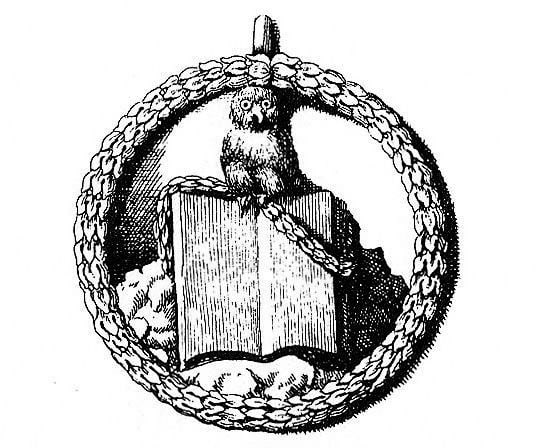
The European Womb
In Part I of this lecture we made a general and all too incomplete survey of who joined the ranks of the Bavarian Illuminati. In Part II of this lecture we will make a deeper examination of what kind of philosophies and practices developed within the society between its founding in 1776 by Adam Weishaupt, and its total annihilation in 1823 with the death of its last leader, Karl Leonard Reinhold.
We will discuss how the Bavarian Order of the Illuminati began and how it ended. Something can be learned yet by a view of the Bavarian Order of the Illuminati in context of the philosophies and politics of its age. In order to understand the Illuminati in context it is instructive to consider a few important aspects of European history.
The tribe known to third century Romans as the Franks (‘the free’) dominated Western Europe for centuries. Eastern peoples came to refer to all Roman Christians (Western Europeans) as “Franks,” especially from the crusades when the term gained general acceptance.
The Franks were a confederation of Germanic tribes who settled in the Gaul of the late Roman Empire, the modern France. They were ruled by two successive dynasties, the Merovingians and then the Carolingians.
The Merovingian kings claimed descent from the Sicambri, a Cimmerian or Scythian tribe, which (according to legend) had changed their name to “Franks” in 11 BCE under the leadership of a certain chieftain called Franko. Franko’s mythological ancestors were said to have been descended from Trojan royalty.

In the seventh century of the Christian Era the Merovingian dynasty, known as the “Do-nothing Kings,” was replaced by the Carolingian family. The family had long been well established politically as the Mayors of the Palace, the de facto head of government. By the next century the Frankish kings, under the Carolingian dynasty, considered themselves the successors to the anointed kings of the Old Testament and to the Roman emperors.
The Carolingian dynasty started with the powerful Mayor of the Palace, Charles Martel, the “Hammer” of the Turks. This ruler stopped the invasion of Islam into France at Poitiers (Battle of Tours), in one of the most decisive battles in history, which preserved Christian Europe against all further Muslim expansion. Charles Martel was the grandfather of Charlemagne, Charles the Great, crowned by the Pope in 800 the first Holy Roman Emperor.
Charles was hailed as the “new Augustus,” but only German states and Northern Italy were to be ruled under the Empire. Other Western European countries remained part of the Church, but maintained local secular rule, and Popes became rivals to the Emperors. The nature of kingship had not changed: and it was weakened to the point that nobles inherited and owned their own land.
In the sixteenth century the fifth Charles was the last Holy Roman Emperor crowned by the Pope. He was the first of the House of Habsburg, which passed as an inheritance the rule of the Holy Roman Empire of the German Nation, supported by powerful prince-electors.
Sovereignty and Peace
The Thirty Years War (1618 – 1648) was a Pan-European struggle over religious dominance and political power, with the French Bourbons and German Habsburgs at the heart of it. The war was ended by the Treaty of Westphalia, a unique invention that stands in contrast to the bloody wars of religion that produced the strictly Catholic France and the Protestant Church of England headed by the monarch.
Under the Treaty of Westphalia, each prince had the right to determine the religion of his own state, whether Roman Catholic, Calvinist or Lutheran. Christians of all of the three accepted denominations had the right to practice their own faith peacefully and according to law within the territories of the parties to the treaty. The Treaty of Westphalia led to the basic international standard that establishes the primacy of national sovereignty over the ambitions of any foreign state or empire.
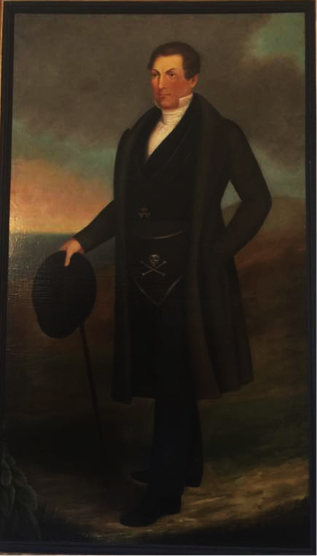
In France feudalism continued such that the king protected the nobles, and the nobles the peasants, until King Louis the XIV claimed his blanket rule by divine right. His father, the Bourbon King Louis XIII, was one of the earliest absolute monarchs, whose First Minister Cardinal de Richelieu (1585 – 1642) originated the position known as Prime Minister.
The powerful Richelieu practiced and promoted raison d’etat, the basis of realism, the philosophy that places the politics of self-interest and power over moral government. This policy was instrumental in forming the system of nationalist states and the balance of power in Europe. France was the dominant power for two hundred years, a system checked only by Britain’s equilibrium policy.
France involved itself in international affairs for centuries and replaced Catholic Spain as the major world power in the eighteenth century. At this time France was involved with colonial expansion and warred with England over territory in America. The French court and aristocracy became pleasure-seekers, travel became popular, and women gained influence in government.
The new cosmopolitan ideal was ‘laissez faire,’ or free trade, for fortune was based on trade instead of land and agriculture. The rising class of bourgeoisie had little political power while the Church and nobility controlled the government, and the proletariat was unfairly taxed. Government faced bankruptcy and summoned parliament, where the third estate demanded the creation of a National Assembly.
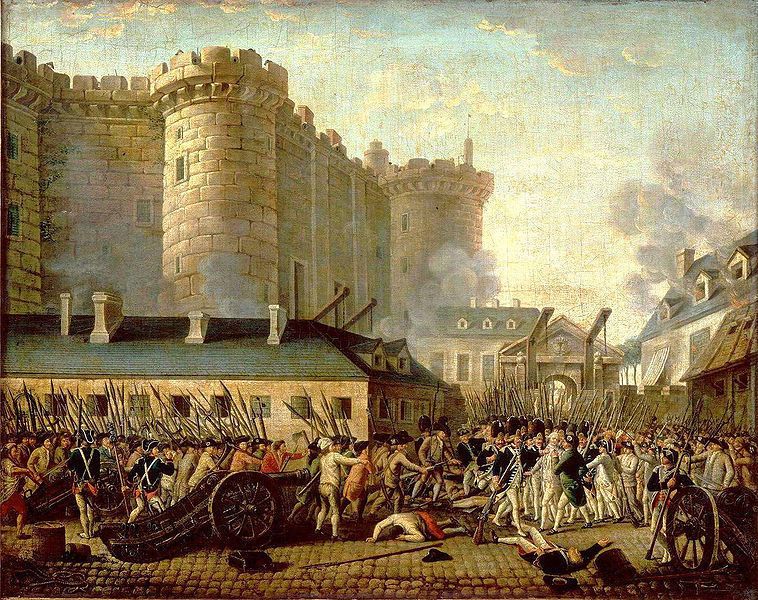
Revolution
In 1789 a mob stormed the Bastille in favor of the Assembly. King Louis XV handed government over to the new National Assembly and the Declaration of the Rights of Man was written. General Lafayette gave keys to the Bastille as gifts to great leaders who had supported revolutionary France in its time of travail.
One key to the Bastille ended up at the George Washington Masonic National Memorial in Alexandria, Virginia. It was given to the Masonic lodge of George Washington in his home town, Alexandria, by General Lafayette, in commemoration of the friendship between revolutionary France and the colonial revolutionaries of the new American Republic.
The French Revolution was complete when King Louis XVI was beheaded and the First Republic, a constitutional monarchy, was formed in 1791. Four successive republics were formed. France declared war on England, Spain, and Holland, in the name of ‘Fraternity,’ to aid everywhere those who wished for liberty.
Revolutions occurred across Europe following the French example, usually resulting in dictatorships that later dissolved into democratic states. Realist Nationalism necessarily arose to trump idealistic universal ‘Fraternity’ as government policy.
The bourgeoisie supported laissez faire “no interference” government policy for control of their own businesses while the working-class supported socialism or regulatory government. In the nineteenth century a powerful army commander and consul named Napoleon Bonaparte was named Emperor. He expanded France’s empire until he was defeated in Russia and his empire eventually broken up.
Since the collapse of Napoleon’s empire, France has been governed by five Republics. It is today a morally liberal leader in the regional North Atlantic Treaty Organization (NATO) and the European Union, as well as the United Nations and other international organizations.

The United States of America
In North America revolution stirred when the American colonies were taxed by Britain for the prolonged conflict with France. The navigation acts, Sugar Act, Stamp Act and Townsend Act were passed by British Parliament to tax the colonies. The economic pressures caused revolutionary organization in the colonies, like the Boston Tea Party.
Parliament passed the Coercive Acts to quarter troops in private homes, try colonial offenders in England, and close the Boston port. The Quebec Act gave land to the French. Thomas Paine wrote his famous rallying cry, Common Sense, in 1776 and the thirteen colonies of America united to revolt against England.
1776 saw the United States Declaration of Independence, 1777 the climactic Battle of Saratoga, and in 1781 Lord Cornwallis surrendered to General Washington. In 1783 the Treaty of Paris ended the war between Great Britain and the United States of America. In 1787 the United States Constitution was written in the Pennsylvania State House in Philadelphia, called Independence Hall.
The Establishment Clause and Free Exercise Clause of the First Amendment to the Constitution of the United States established the separation of church and state following Thomas Jefferson’s concept of “a wall of separation between church and state.” The No Religious Test Clause of the Constitution was written in Article Four, paragraph three.
The United States government was created alongside the Episcopal Church, the independent American branch of the Church of England, which built the Washington National Cathedral. The Constitution was ratified on the fourth of March in 1789.
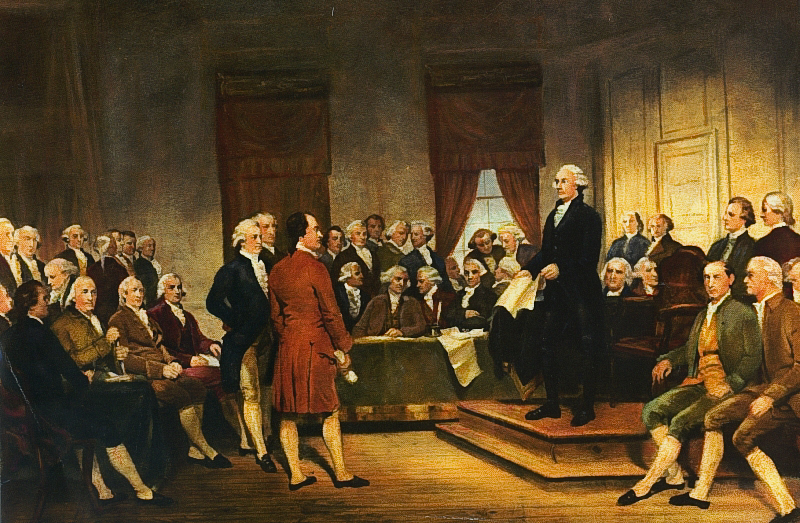
The new nation arose amid the burden of a natural power struggle between the urban elite in the North and the mostly rural population of the South. The embryonic Federal government assumed New York’s debt in exchange for a political agreement to build Washington, D. C., the new nation’s capital, on the Potomac River. The location, drawn as an equilateral square, included George Washington’s hometown of Alexandria, Virginia and parts of Maryland, a midpoint between North and South.
The New York Stock Exchange was formed after a boom in the trading of stocks and government bonds. The expectation of growth was not unfounded and as the Republic grew, it formed its own unique democratic society and laws, which recently for a time (the latter half of the twentieth century) enjoyed the envy of the world for its technology and military power, its ideal of equality, its protection of civil liberties and its opportunities for prosperity. The nation maintains a primary leadership role in the maintenance of a peaceful world order to this day.
It may now be shown how the Bavarian Order of the Illuminati was relevant to this global civilization; and why this secret order of revolutionaries has been labeled as both enlightened philanthropists and devil-worshipping anarchists.
In Germany sermons by Jesuit sympathizers accusing the Illuminati of alliance with the Antichrist began as early as 1781. The Jesuit order would even go so far to attack the Illuminati as to collaborate with their traditional rivals, the German Protestant academic mystical order that identified itself as Rosicrucian.
The Rosicrucians of the Golden and Rosy Cross, established in the Aux trois Globes Lodge in Munich, were persistent in their antagonism against what they perceived to be an order of revolutionary atheists. In 1784 the first publications openly critical of the Bavarian Illuminati were printed anonymously.
The American revolutionaries had very different ideas from the European establishment in regards the separation of church and state. Among the defenders of the Illuminati was the American President Thomas Jefferson, whose views are well expounded in a letter written to Reverend James Madison on January 31, 1800.
The manuscript is preserved in the Library of Congress. Jefferson asserted that in the young United States of America, Weishaupt would not have needed a secret society, for his principles were in accord with the spirit and the rule of the new republic. (See the Appendix at the end of this article for the contents of Jefferson’s letter.)
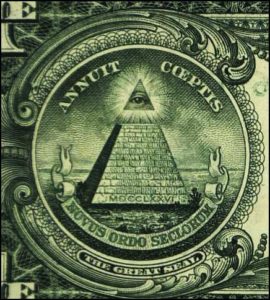
Freemasonry and the Illuminati Under Attack
In 1782 the Order of Strict Observance was disbanded and many of its members entered the ranks of the Illuminati. In 1784 Elector Karl Theodor the Duke of Bavaria issued an edict against all societies not sanctioned by his government. In 1785 Weishaupt was dismissed from his university position for acquiring atheistic literature and Elector Karl Theodor the Duke of Bavaria issued another edict. This time the edict was specifically against Freemasonry and the Illuminati.
Weishaupt fled Bavaria and was given sanctuary at the court of Saxe-Gotha. He was forced to hide as posters called for his capture and arrest. Weishaupt was also given diplomatic immunity under Duke Ernst’s embassy. State officials, military men, professors, and others were dismissed from their jobs or banished. Upon discovery of the continued existence of the Illuminati, the Elector issued a third edict, threatening “severe punishment” for those who did not repent and confess.
At its height in the 1780s the order had about 2,500 members (Terry Melanson, The Perfectibilists, Chapter Two, “Diaspora”). Johann Joachim Christoph Bode (1730 – 1793), a translator, led the order after Weishaupt fled Bavaria, until his death in 1793. The order is traditionally considered to have disintegrated after the third Edict of the Elector, which threatened death by sword to recruiters, forfeiture of property and banishment. However, another edict, a self-described “merciless” death threat, was issued in 1790.
This example of absolute tyranny and abuse of power illustrates well the very evils the Order of the Illuminati was created to end. A check to this tragic state of government was finally realized in the Constitution of the United States of America, which in this sense, has inspired much of what calls itself the ‘Free World.’ The tyrant succeeded in dismantling the order that threatened his power, but he failed to quench the flames of liberty, as the ideals of the Illuminati not only survived, but continue to thrive and grow to this day.
The Movement Lives On
There is no lack of evidence for a continued movement. The Illuminati remained underground, forming and infiltrating various reading societies and Masonic lodges.
Reading societies were meetings where discussions of Enlightenment literature and the issues of the day were held, which were conversational, and generally lacked any form of mystical ritual. They also operated in Jacobin clubs, whose revolutionary political organization was the biggest and most influential during the French Revolution- not to be confused with the Jacobites, supporters of the House of Stuart in Britain.
The Philalethes system or Amis Reunis of Truth was related to the Illuminati. Bode initiated Francois-Marie, Marquis de Chefdebien d’Armissan (1753 – 1814). The Marquis was one of the Chefdebien family members that started their own lodge in Norbonne following a degree system based on the Philalethes.
The Primitive Rite of Norbonne was the antecedent to the Primitive Rite of Memphis-Mizraim, and was already called the Primitive Rite of the Philadelphes ten years before Bode named the Illuminati in France the ‘Philadelphes.’ The Chefdebien Philadelphes entered into union with the Philalethes of Savalette de Langes and the Grand Orient of France in the mid-1780s.

Thomas Paine and others founded the first church of Theophilanthropy (God – Love – Man) in Paris in 1797. The secular, Gnostic, deist membership worshipped by singing humanist hymns and reading from Greek, Biblical, Chinese, Indian, and other sources. Francois-Antoine Lemoyne Daubermesnil (1748- 1802) played a leading role in revolutionary Freemasonry as a member of Langes’ Amis Reunis, an officer of a Narbonne lodge and an officer in the Grand Orient of France. He was brought into the Illuminati order by J.J.C. Bode.
Daubermesnil’s 1796 rites of the Adorateurs, or Cult of Adorers, was a form of the Theophilanthropes. They were printed by Nicolas de Bonneville’s (1760 – 1828) Cercle Social in Paris, radical publishers during the French Revolution. Bonneville was friends with J.J.C. Bode and Thomas Paine and, as a revolutionary, inspired Karl Marx and Friedrich Engels.
Bonneville also published material by the mystic Louis Claude de Saint-Martin of Lyon. Le Loge des Neuf Soeurs or Lodge of the Nine Sisters in Paris helped provide membership for the Church of Theophilanthropy before Napoleon abolished the religion in France in 1801 in favor of the Vatican. The Lodge Les Neuf Soeurs was named in reverence of the Nine Muses of Classical Greek mythology, patronesses of the liberal arts, and included members like Benjamin Franklin and Voltaire.
Adam Weishaupt translated and published part of Gébelin’s Monde Primitif; which was used in the ritual of the Lodge of the Nine Sisters. Antoine Court de Gébelin, a famous Huguenot pastor and Tarot card scholar, was a member of Les Amis Réunis and Secretary of Le Loge des Neuf Soeurs in 1778. Gébelin initiated Benjamin Franklin, who later became Worshipful Master of the lodge. Franklin, himself, led the aging Voltaire thru his Masonic degrees in the Lodge of the Nine Sisters. The Marquis de Lafayette, George Washington’s dear friend and ally, was also a member of the lodge.
As it turned out, Emperor Maximilian Joseph followed Karl Theodor to the throne of Bavaria and hired Illuminati into the government bureaucracy. The next emperor, Joseph’s brother Leopold II, started his own secret society called “the Association,” to check against the aristocratic Illuminati, who he perceived to have impeded his brother’s government. When Leopold II died in early 1792, Francis II took the seat of power. He became the last Holy Roman Emperor when Napoleon dismantled the Empire in 1806.

The Question of Succession
The English poet Percy Bysshe Shelley (1792 – 1822) was so endeared to the principles of the Illuminati as he read them in Barreul’s exposé that in 1811 he made a public attempt to create his own secret society in emulation of the order. The Illuminati movement survived in America, especially aimed at education, and can be recognized as the precursor of the Skull and Bones.
Daniel Coit Gilman (1831 – 1908) founded the Yale-based Order of Skull & Bones legal trust, and was first President at Johns Hopkins University and first President of the Carnegie Foundation. The evidence of a connection between the Illuminati and the Skull and Bones is summed up in Chapter Four of Terry Melanson’s Perfectibilists: the 18th Century Bavarian Order of the Illuminati, 2011.
The active Illuminati chief J.J.C. Bode, the philosopher Karl Leonard Reinhold (1757 – 1823), and other Illuminati perpetuated Illuminati objectives and work within Freemasonry. They pressed for the replacement of mystical fraternal rites of numerous degrees with rational ones of three degrees. Reinhold became the dominant figure within the Illuminati movement after J.J.C. Bode died, and the original movement seems to have died with him.
Although a loosely defined Illuminist movement has continued even into the present day, unless there is a real connection with the Skull and Bones, the Bavarian Order of the Illuminati officially ended with Karl Leonard Reinhold in 1823. Since that time many fraternal societies have adopted some form of the name Illuminati or claimed some identification with the order, the primary of these perhaps being the early twentieth century Ordo Templi Orientis (O.T.O.) or Order of the Temple of the East, which uses the name in its degree structure.
Edward Alexander (Aleister) Crowley (1875 – 1947), the main force behind the current O.T.O., began his search for an enlightened community of adepts by contacting the Masonic author Arthur Edward Waite. On Waite’s advice, Crowley read The Cloud Upon the Sanctuary by Franz Karl von Eckartshausen (1752 – 1803), an Illuminatus whose stage work was recommended to initiates since the late 1770s. Waite was a member of the Rosicrucian magical society the Hermetic Order of the Golden Dawn, where the anti-theist Crowley would later learn the basics of his alchemy and magic.
Crowley’s own revelations, summed up in the Greek word Thelema, ‘True Will,’ has informed the O.T.O. since he became head of the fraternal religious order in 1925. The central tenets of Thelema, expressed in the Book of the Law (1904), are “Do What Thou Wilt” and “Love is the Law, Love under Will.” In his quest for a well-regulated community of private researchers dedicated to the science of mystical enlightenment, Crowley created his own secular order of ‘Scientific Illuminism,’ the Argenteum Astrum (A.’.A.’.) or ‘Silver Star,’ which operates today under the leadership of an American Freemason.

Truth v. Conspiracy Theories
The Illuminati has been the target of ridiculous conspiracy theories involving everything from devil worship, to covert alien invasions, to political and military intrigues of a sinister New World Order controlled by the socio-economic elite. Critics of the order who do not understand the lofty ideals of secular mysticism (the Western Mystery Tradition) and rational humanism accuse the Illuminati of designing to undermine faith, family, liberty, property, national patriotism, and government- the very fabric of society.
Along with suspicions of attempting to overthrow the status quo, a contrary accusation is often made, often in the person of a single critic, equating the Illuminati with the established wealthy power elite and globalization. The oligarchy or bureaucracy is faulted for organized corruption and the resulting ills of the less advantaged 99.9% of the world.
Somehow the benefits of global development, like security, trade, regulation, and improved quality of life, are ignored by these naysayers. The natural burdens on humankind, like want and war, of course, are to blame on a small tribe of all-powerful “Illuminati.” These detractors have thus associated the name “Illuminati,” in a colossal twist of irony, with an elite cabal that exists as a threat to the welfare and liberty of humankind.
The order was dissolved before it achieved its aims, ostensibly the universal aspirations of all humankind, but many of the objectives of the order have come to pass. The Illuminati’s vision of a humanist global society without need for government has yet to manifest, but its political objective of weakening monarchs was accomplished with the transmutation of the absolute monarchies of Europe – usually maintained by argument of Divine Right – into democratic governments limited by a legally binding constitution.
The order schemed to make the world secure and just with the engineering of a unified global government of Illuminati with ends similar to those declared by the United Nations Organization and the World Bank. They plotted to undermine the power of the Church with rationalism and humanism. They conspired to establish equal rights for men and women, and they supported the legalization of family planning, abortion and divorce.
In fact, the civilized world today compared with the world during Revolutionary times looks very much like it has been built on the blueprint of the New World Order envisioned by the prophetic Illuminati. Today one must conclude an examination of the Bavarian order wondering what further influence the present resurgence of interest in the Illuminati might indicate for the future.

APPENDIX: Thomas Jefferson’s defense of the Illuminati
The Works of Thomas Jefferson in Twelve Volumes. Federal Edition. Collected and Edited by Paul Leicester Ford.
Thomas Jefferson to Reverend James Madison, January 31, 1800
Philadelphia, Jan. 31, 1800.
Dear Sir,–* * * I have lately by accident got a sight of a single volume (the 3d.) of the Abbe Barruel’s Antisocial conspiracy, which gives me the first idea I have ever had of what is meant by the Illuminatism against which “illuminate Morse” as he is now called, & his ecclesiastical & monarchical associates have been making such a hue and cry. Barruel’s own parts of the book are perfectly the ravings of a Bedlamite. But he quotes largely from Wishaupt whom he considers as the founder of what he calls the order. As you may not have had an opportunity of forming a judgment of this cry of “mad dog” which has been raised against his doctrines, I will give you the idea I have formed from only an hour’s reading of Barruel’s quotations from him, which you may be sure are not the most favorable.
Wishaupt seems to be an enthusiastic Philanthropist. He is among those (as you know the excellent Price and Priestley also are) who believe in the indefinite perfectibility of man. He thinks he may in time be rendered so perfect that he will be able to govern himself in every circumstance so as to injure none, to do all the good he can, to leave government no occasion to exercise their powers over him, & of course to render political government useless. This you know is Godwin’s doctrine, and this is what Robinson, Barruel & Morse had called a conspiracy against all government.
Wishaupt believes that to promote this perfection of the human character was the object of Jesus Christ. That his intention was simply to reinstate natural religion, & by diffusing the light of his morality, to teach us to govern ourselves. His precepts are the love of god & love of our neighbor. And by teaching innocence of conduct, he expected to place men in their natural state of liberty & equality. He says, no one ever laid a surer foundation for liberty than our grand master, Jesus of Nazareth. He believes the Free masons were originally possessed of the true principles & objects of Christianity, & have still preserved some of them by tradition, but much disfigured.
The means he proposes to effect this improvement of human nature are “to enlighten men, to correct their morals & inspire them with benevolence. Secure of our success, sais he, we abstain from violent commotions. To have foreseen, the happiness of posterity & to have prepared it by irreproachable means, suffices for our felicity. The tranquility of our consciences is not troubled by the reproach of aiming at the ruin or overthrow of states or thrones.”
As Wishaupt lived under the tyranny of a despot & priests, he knew that caution was necessary even in spreading information, & the principles of pure morality. He proposed therefore to lead the Free masons to adopt this object & to make the objects of their institution the diffusion of science & virtue. He proposed to initiate new members into his body by gradations proportioned to his fears of the thunderbolts of tyranny. This has given an air of mystery to his views, was the foundation of his banishment, the subversion of the masonic order, & is the colour for the ravings against him of Robinson, Barruel & Morse, whose real fears are that the craft would be endangered by the spreading of information, reason, & natural morality among men.
This subject being new to me, I have imagined that if it be so to you also, you may receive the same satisfaction in seeing, which I have had in forming the analysis of it: & I believe you will think with me that if Wishaupt had written here, where no secrecy is necessary in our endeavors to render men wise & virtuous, he would not have thought of any secret machinery for that purpose. As Godwin, if he had written in Germany, might probably also have thought secrecy & mysticism prudent. I will say nothing to you on the late revolution of France, which is painfully interesting. Perhaps when we know more of the circumstances which gave rise to it, & the direction it will take, Buonaparte, its chief organ, may stand in a better light than at present. I am with great esteem, dear sir, your affectionate friend.



